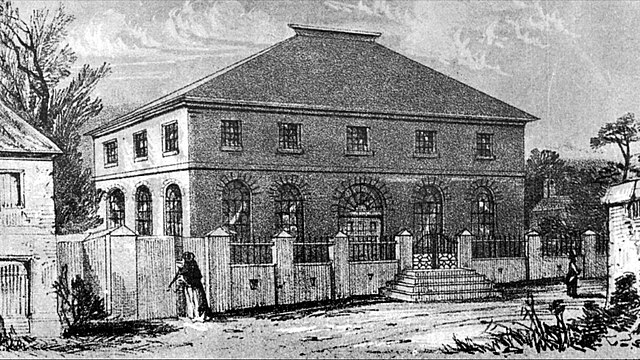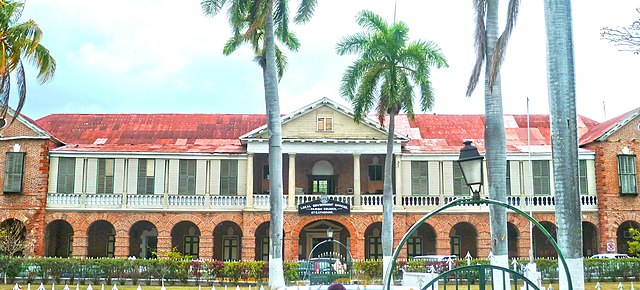Top Qs
Timeline
Chat
Perspective
Spanish Town
Town in Middlesex, Jamaica From Wikipedia, the free encyclopedia
Remove ads
Spanish Town (Jamaican Patois: Spain) is the capital and the largest town in the parish of St. Catherine in the historic county of Middlesex, Jamaica. It was the Spanish and British capital of Jamaica from 1534 until 1872. The town is home to numerous memorials, the national archives, and one of the oldest Anglican churches outside England (the others are in Virginia, Maryland, and Bermuda).
Remove ads
Remove ads
History
Summarize
Perspective



The Spanish settlement of Villa de la Vega was founded by the Spanish in 1534 as the capital of the colony. Later, it was also called Santiago de la Vega or St. Jago de la Vega.[4] Indigenous Taino had been living in the area for approximately a millennium before this, but this was the first European habitation on the south of the island.
When the English conquered Jamaica in 1655, they renamed the settlement as Spanish Town in honour to the original Spanish root of this town. Since the town was badly damaged during the conquest, Port Royal took on many administrative roles and functioned as an unofficial capital during the beginning of English rule. By the time Port Royal was devastated by an earthquake in 1692, Spanish Town had been rebuilt and was again functioning as the capital. Spanish Town remained the capital until 1872, when the seat of the colony was moved to Kingston.
Kingston had been founded in the aftermath of the 1692 earthquake. By 1755, serious rivalry from lobbyists caused increasing speculation about the continued suitability of Spanish Town as the capital. In 1836, Governor Lionel Smith observed that "the capital was in ruins, with no commercial, manufacturing and agricultural concern in operation."[citation needed] To worsen the situation, following the Morant Bay Rebellion of 1865, Sir John Peter Grant ordered the removal of the capital in 1872 to Kingston. As a larger port, it had come to be considered the natural capital of the island. After the seat of government was relocated, Spanish Town lost much of its economic and cultural vitality.
Remove ads
Points of interest
Summarize
Perspective
Built on the west bank of the Rio Cobre, the town lies 13 miles from Kingston on the main road. Its history was shaped by two significant colonial periods: Spanish rule from 1534 to 1655 and the English from 1655 to 1872. After that the capital was relocated to Kingston. The Anglican Church took over the 16th century cathedral.
The historic architecture and street names mark the colonial history, such as Red Church and White Church streets, symbolic of the Spanish chapels of the red and white cross, as well as Monk Street, in reference to the monastery that once stood nearby. Nugent and Manchester streets were named for the British Colonial Governors, George Nugent and William Montagu, 5th Duke of Manchester. King Street runs past the King's House, the governor's residence, and Constitution Street, near to the Square, refers to the island's former administrative centre. Regency buildings in the town centre include the Rodney Memorial flanked by two guns from the French ship Ville de Paris (1764),[5] and the façade of the Old King's House, which was the residence of the governor until 1872.
Old Iron Bridge

Spanish Town is the site of an early cast-iron bridge, designed by Thomas Wilson and manufactured by Walker and Company of Rotherham, England. Spanning the Rio Cobre, the bridge was erected in 1801 at a cost of £4,000.[6] Its four arched ribs are supported on massive masonry abutments. After the abutments deteriorated, endangering the structure, it was listed in the 1998 World Monuments Watch by the World Monuments Fund.[7]
A restoration project began in 2004, with funding provided by American Express through World Monuments Fund.[8] Progress was slow until 2008, when a renewed restoration effort was made. A first phase of restoration was completed in April 2010, when the repair of the abutments allowed the bridge to be reopened for the public.[9] More recently, violence in the area has prevented the bridge from achieving the status of a UNESCO World Heritage Site.[10]
Remove ads
Today
In 2009, the population of Spanish Town was estimated to be about 160,000.[1] The population of Spanish Town, like the rest of the St. Catherine, has been growing rapidly.
It is sometimes referred to colloquially as "Spain" or "Prison Oval" within Jamaica. The latter nickname is a reference to the cricket pitch or oval located just outside the St. Catherine District Prison, where some inmates can get a limited view of the sport through their cell windows. Association football is also played at the Prison Oval; Rivoli United F.C. is the major team.
The town had one of the first Spanish cathedrals to be built in the New World, constructed around 1525. Many Christian denominations have churches or meeting halls in the town, including a Roman Catholic church and Wesleyan, Baptist and Seventh-day Adventist chapels. There is also a mosque.[11]
Standing untouched in character is a historic alms-house, public hospital, and a penal institution built in the eighteenth century. The town contains a factory that manufactures dyes from logwood, a salt factory, and a rice processing plant. In the neighbourhood are five large sugar estates, a milk condensary, and a large textile mill.
Government and infrastructure
The Rio Cobre Juvenile Correctional Centre of the Department of Correctional Services, Jamaica is located in Spanish Town.[12]
Transport
Roads
Spanish Town is on the main A1 (Kingston to Lucea) and A2 (Spanish Town to Savanna-la-Mar) roads.[13] It is well served by buses, mini buses and taxis, which operate from the Spanish Town Transport Hub.
Rail
The now disused Spanish Town railway station formerly provided access to four lines:
The station opened in 1845 and closed in October 1992 when all passenger traffic on Jamaica's railways abruptly ceased.[14]
Remove ads
Notable people


- Ivy Baxter (1923–1993), pioneer in the field of Jamaican dance
- Yohan Blake, sprinter, attended school in Spanish Town
- Anne Brodbelt (1751–1827), letter writer and social observer
- Cornel Chin-Sue, footballer
- Davian Clarke, sprinter
- Chronixx, singer
- Chevelle Franklyn, gospel reggae singer, born in Tawes Pen, Spanish Town
- DJ Akademiks, YouTuber and podcaster, born in Spanish Town
- Lutan Fyah, reggae singer
- Ma Lou, potter
- Rajiv Maragh, Jockey
- Uriah Hall, mixed martial artist, born in Spanish Town
- Andrew Holness, politician, Prime Minister of Jamaica
- Jason Jackson, mixed martial artist
- Randy Brown, mixed martial artist
- Grace Jones, singer and actress, born in Spanish Town
- Diana King, reggae singer, born in Spanish Town
- Koffee, reggae singer/rapper, born in Spanish Town
- Jermaine Lawson, cricketer
- Amelia Lewsham, "White Negress" born in Spanish Town in the 1740s[15]
- Oswald George Powe, political and equality activist, born in Kingston but later based in Spanish Town
- Prince Far I, reggae deejay, born in Spanish Town
- Kirk Diamond, reggae singer and social activist.
- Bunny Shaw, Jamaican woman footballer
- Shirley Anne Tate, Jamaican sociologist, scholar, researcher, educator, and author; born in Spanish Town.[16]
- Spice, dancehall musician, born in Spanish Town
- Alfred Valentine, cricketer
- Micheal Ward, British actor, born in Spanish Town
- Precious Wilson, soul singer, born in Spanish Town
- Harry Mudie, Jamaican record producer, born in Spanish Town
Remove ads
References
Other sources
Wikiwand - on
Seamless Wikipedia browsing. On steroids.
Remove ads


